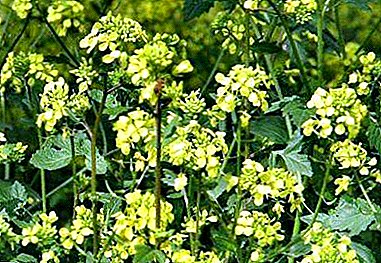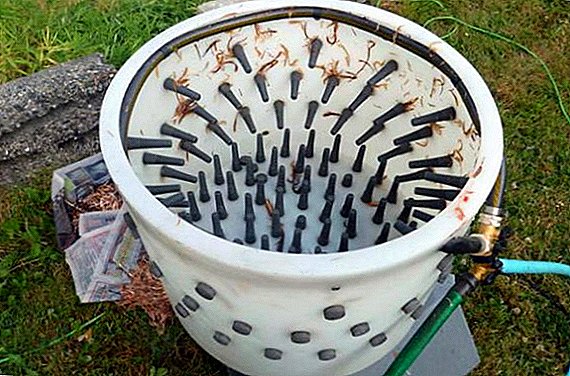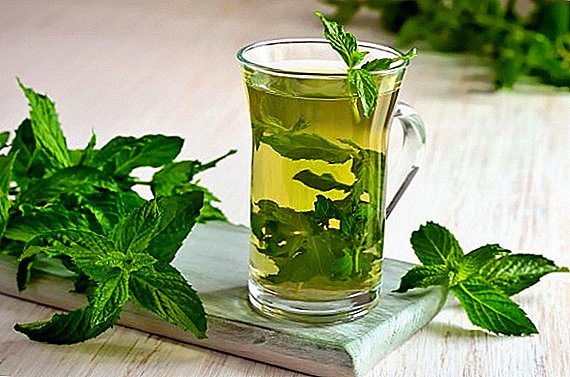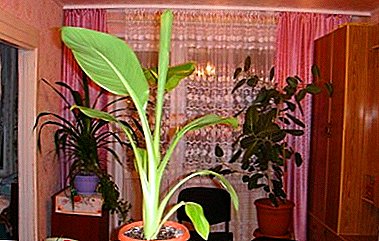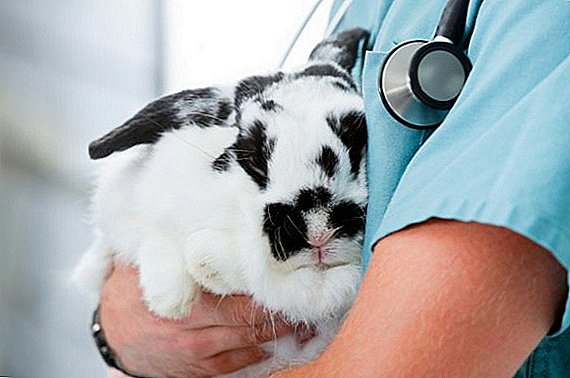 Diseases of ornamental rabbit breeds are diverse and can be quite dangerous. A characteristic feature of such breeds is reduced immunity as a side effect of breeding. Therefore, the symptoms of disease need to be especially careful and know how to help your pet. In the article we will consider various diseases of rabbits, especially their course, treatment, as well as preventive measures.
Diseases of ornamental rabbit breeds are diverse and can be quite dangerous. A characteristic feature of such breeds is reduced immunity as a side effect of breeding. Therefore, the symptoms of disease need to be especially careful and know how to help your pet. In the article we will consider various diseases of rabbits, especially their course, treatment, as well as preventive measures.
How to understand that the rabbit got sick
The main external signs of the disease:
- the presence of discharge from the nose or eyes;
- sneezing;
- diarrhea or constipation;
- dull, felted wool;
- strange behavior (aggressive, sleepy, etc.);
- rashes, sores on the skin;
- the presence of fleas;
- fever.
Find out why the rabbit has hair, why the eyes of rabbits are swollen and watery.If any of the listed symptoms of the ornamental rabbit are found, it is necessary to isolate it from other pets and contact a veterinarian. It is dangerous that some diseases can be transmitted to humans - scabies, ringworm and others. So, in contact with the pet, you need to observe precautions.

How to measure rabbit temperature
The normal body temperature of any rabbit can be in the range of + 38.8 ° to + 39.5 ° C. In hot weather, it is possible to increase to + 41 ° С, and in cold weather - to lower to + 37 ° С.
Did you know? In the world there are about 200 decorative breeds of rabbits. In this variety there are large and small, short-haired and long-haired varieties.
To measure the temperature will need a medical plastic thermometer. It must be inserted into the anus of a rabbit by 1-1.5 cm. The measurement time is 6-8 minutes.
- To measure a pet stack on a flat horizontal surface.
- If he is nervous and breaks out, you need to stroke and calm him.
- To keep the rabbit from tearing out during the procedure and not getting injured, you need to hold the front and hind legs. To do this, it is desirable to get an assistant.

Types of disease
All diseases can be divided into three groups:
- infectious;
- skin;
- diseases of the gastrointestinal tract.
Find out what diseases of rabbits are dangerous to humans.
For skin diseases a characteristic change in the skin under the action of bacteria, parasites, with mechanical action (impact, scratch), etc. Skin diseases are treatable, the main thing is to recognize the disease in time and start treatment.
Diseases of the gastrointestinal tract characterized by disorders in the stomach, esophagus, liver, biliary tract, intestines. They can be both infectious and non-infectious, including hereditary. 
Infectious
Infectious diseases are the result of the effects of viruses and bacteria on the body. In order for a pet to fall ill, the microorganism must begin to excrete toxins under the influence of the immune system. Intoxication occurs as a result of exposure to the waste products of a microorganism or the release of toxins at the time of its death.
Did you know? The ornamental rabbit needs mandatory walks at least 4 hours a day. If the animal is kept in a cage all the time, osteoporosis will develop.
Duration depends on the type of pathogen and can be either instantaneous (from 1 to 4 days) or chronic, lasting several months. The susceptibility to infections depends on:
- pet age;
- vaccination;
- associated diseases;
- power supply.

Myxomatosis
Myxomatosis is a disease characterized by the development of conjunctivitis with purulent secretions, the presence of tumors in the area of the head, anus and external genital organs. It is caused by the virus Myxomatosis cuniculorum.
The infection is spread by mechanical carriers - mosquitoes, fleas, bedbugs. The virus is concentrated in the blood of a sick animal. It can be excreted into the external environment with the help of nasal and ocular secretions.
Learn what are and how to treat rabbit ear diseases.Symptoms:
- swelling on the head;
- eye inflammation accompanied by purulent secretions;
- nasal discharge;
- body temperature rises to + 42 ° C;
- general weakness.
 Prevention:
Prevention:- vaccination of young animals is carried out at the age of 1 month and after 3 months - revaccination;
- the injection is injected subcutaneously. Duration of action - 9 months;
- in the case of disease in vaccinated individuals, it proceeds more easily, in a nodular form. The treatment includes antibiotics and immunomodulators.
- injection - "Gamavit" 0.2 ml subcutaneously 1 time per day until recovery;
- “Baytril” is added to drinking at the rate of 0.2 ml per 10 kg of live weight;
- eyes are buried with "Ofloxacin";
- nose buried "Aquamaris";
- open wounds are treated with iodine.
 If rabbits are kept in the rabbit, then pest control is performed daily. Her goal - the destruction of bloodsucking insects. For a pet, treatment with parasite products is made in accordance with the instructions of the veterinarian.
If rabbits are kept in the rabbit, then pest control is performed daily. Her goal - the destruction of bloodsucking insects. For a pet, treatment with parasite products is made in accordance with the instructions of the veterinarian.Important! The period of the greatest activity of bloodsucking insects is May and June. At this time, habitat pest control is important for all rabbits.
Infectious rhinitis
The cause of the disease - non-compliance with the rules of hygiene: lack of fresh air, dirty litter, dust rising from hay. The disease can begin as a common cold, and eventually turn into an infectious.
Symptoms:
- rabbit rubs nose paws;
- sneezes
- nose increased in size;
- presence of purulent discharge from the nose.

Treatment:
- food should contain greens, drink - decoction of chamomile;
- eyes and nose are treated with saline;
- antibiotics are prescribed by a doctor until symptoms disappear;
- perhaps the appointment of a doctor of drugs to support the gastrointestinal tract.
Prevention of rhinitis is the maintenance of humidity at the level of 55-60%, regular change of litter, proper nutrition.
Learn how to distinguish between allergies to rabbits in children and adults.
Pneumonia
Inflammation of the lungs is caused by hypothermia, weakening of the immune system after suffering diseases and drafts in the room.
Main symptoms:
- high body temperature;
- depressed state;
- nasal discharge;
- cough, shortness of breath, wheezing.
 Diagnosis of pneumonia Treatment:
Diagnosis of pneumonia Treatment:- broad-spectrum antibiotics - "Kobaktan", "Baytril" or others (as prescribed by the doctor);
- analgesics are used to relieve fever and inflammation - "Meloxicam", "Ketoprofen";
- immunomodulators - Albuvir, Gamavit.
All drugs are prescribed by a doctor and in accordance with the prescribed dosage.
Important! The following antibiotics - Ampicillin, Lincomycin, Clindamycin are contraindicated in rabbit: they can cause the death of an animal. Penicillin antibiotics cause diarrhea and are also undesirable. Carefully study the composition of drugs when buying!
Pasteurellosis
Pasteurellosis is caused by Pasteurella multocida. Infection occurs through contact with an infected animal or mechanical carriers: man, drinkers, feeders, soil, etc. It manifests itself in the form of purulent rhinitis, pneumonia, abscesses, blood poisoning.
 Symptoms:
Symptoms:
- conjunctivitis;
- mucous discharge from the eyes and nose;
- purulent wounds on the skin;
- increased body temperature;
- diarrhea, flatulence;
- lethargy.
Learn how to choose toys for rabbits.
Pasteurellosis is one of the most dangerous diseases. To establish an accurate diagnosis of an ornamental rabbit, it is imperative that you deliver it to a veterinarian.
Treatment:
- antibiotic "Biomitsin" intramuscularly at the rate of 25 units per 1 kg of animal weight 2 times a day for 3-4 days;
- sulfonamides in tablets - 0.2-0.3 g per 1 adult rabbit and 0.1-0.2 g per young animals up to 1 year.

The combination of drugs shows good results: antibiotics and sulfonamides alternate in a few days. The scheme and dosage must appoint a doctor. For the prevention of disease, animals are vaccinated with a formolvaccine or analogue, starting from 1 month, 2 times a year.
Important! The initial symptoms of pasteurellosis are typical of many diseases, so a doctor’s consultation is required for diagnosis.
Infectious stomatitis
"Wet face" or infectious stomatitis is a viral disease that affects young animals up to 3 months.
Symptoms:
- increased salivation;
- white films and sores on the tongue;
- wet coat on the face, abdomen and paws;
- diarrhea;
- lethargy;
- loss of appetite;
- itchiness

Treatment:
- disinfection of the oral cavity by spraying a solution of potassium permanganate (0.15%);
- antibiotic "Penicillin" orally 1 time per day (0.1 g) for 3 days;
- wipe the wool with a solution of copper sulphate 2%, 2 times a day for 3 days;
- on the mucous membrane of the mouth to apply a streptocidal emulsion;
- You can give a crushed streptocide tablet.
Check out the breeds of ornamental rabbits.
Conjunctivitis
The cause of conjunctivitis can be the introduction of dust, dirt, infection, drafts in the room, etc.
Symptoms:
- redness of the eye or mucosa, eyelid;
- swelling;
- tearing;
- appearance of discharge from the eye.

Treatment:
- bury his eyes with drops of "Levomitsetin", 2 drops 4 times a day;
- To prevent inflammation of the skin of the cheeks, lubricate the cheeks and eyelids with boric ointment 2 times a day.
Important! Conjunctivitis can cause a lack of vitamin A in the body: add carrots and other greens to the pet's diet.
Skin ailments
Provocative factors for skin diseases can be:
- poor nutrition - lack of vitamins;
- skin parasites;
- mechanical damage to the skin;
- infectious diseases.
Allergies can also cause skin lesions. It can be triggered by ordinary dust, hay dust, food, chemical irritants. Treatment is prescribed after the doctor has established an accurate diagnosis.
Ringworm
Ringworm is a disease that is caused by parasitic fungi. Breeding fungus spores. Infection occurs when the level of humidity in the room rises above 65%. The ornamental rabbit becomes infected when it comes into contact with a sick rabbit or an inventory, food, or cage of a sick animal. For rabbitks, the cause of the disease is poor hygiene and lack of disinfection. The source of infection can be insects, rodents, other animals, etc.
The ornamental rabbit becomes infected when it comes into contact with a sick rabbit or an inventory, food, or cage of a sick animal. For rabbitks, the cause of the disease is poor hygiene and lack of disinfection. The source of infection can be insects, rodents, other animals, etc.
Symptoms:
- round spots on the face of a rabbit (eyelids, lips, nose, ears);
- then an inflammatory process occurs - pus, sores, scabs appear;
- itching;
- bald head
- hair is removed around the affected area;
- the surface is disinfected with a solution of "chlorhexidine";
- antifungal and antibacterial treatment of the affected area "Surolan" 2 times a day for 15 days.
Important! There is an opinion that ringworm is caused by a lack of vitamin C, therefore, the pet's diet must contain products with its high content.
Poddermatit
Pododermatitis, or natoptysh, is formed from the inconsistency of the conditions of detention and features of the rabbit. For example, the Royal Rabbit is genetically predisposed to the disease. Representatives of large breeds, with cellular content, rub their paws on the cage due to their weight. 
Causes of illness:
- weight;
- wrong paw setting;
- age for older individuals;
- long claw length;
- inactivity;
- genetic predisposition.
- wounds on paws;
- boils;
- sores
The danger is the possibility of entering a secondary infection into the body through the wound surface.
One of the reasons for poddermatit is the wrong gender, learn how to make sex for rabbits.
The treatment consists of:
- treatment and disinfection of "Chlorhexidine";
- treatment of the inflammatory process "Dermatol";
- dressing.

Treatment and dressing repeated daily. If there is damage to the paw to the bone, then the animal must be taken to the doctor: you may need to apply a plaster cast.
If the disease is provoked by long claws, then the doctor can cut them; in the same place will take measures in case of incorrect setting of the paw. And of course, the decorative rabbit needs to replace the texture of the floor, if the disease arose from rubbing the paws on the cage.
Learn how not to feed rabbits.
Scabies
Scabies, or psoroptes, is a disease caused by skin parasites: Psoroptes mites. You can become infected with a tick from contact with an infected animal or with vectors of the disease - inventory, bedding, food, water.
Symptoms:
- the animal is restless;
- rubs his face with his paws and shakes his head in an attempt to get rid of the tick;
- inflammation begins on the inner surface of the ears;
- wounds, ulcers, vesicles appear;
- purulent discharge in the ears.
 Treatment:
Treatment:- acaricidal sprays or ointments treat the ears with Stronghold, Psoroptol or others;
- injections of "Otodektin" subcutaneously at the rate of 0.1-0.2 mg per 1 kg of animal weight.
The course of treatment lasts 5-7 days and is prescribed by a veterinarian.
Important! Rabbits, including decorative ones, love to gnaw. Therefore, remove any wires from the zone of contact with the pet - it will save him from electrical shocks.
Diseases of the digestive tract
Diseases of the gastrointestinal tract are characterized by nausea, vomiting, diarrhea or constipation, pain. Most often occur acutely and are accompanied by a decrease in immunity, the general deterioration of the animal.
Main reasons:
- unhealthy diet;
- contact with infected animals.

Nematodiroz (worms)
Worm disease caused by a nematode. Parasite ingestion is possible with fresh grass. The disease may not have external symptoms for a long time.
Symptoms:
- weight loss;
- loss of appetite;
- diarrhea;
- parts of worms in feces;
- delayed weight gain.
- Immunomodulator "Gamavit" subcutaneously at the rate of 0.5 mg per 1 kg of body weight to reduce the intoxication of the body, for 8 days;
- anthelmintic drug "Albendazole" in the morning and evening.
Did you know? In the wild, predatory animals and birds attack lagomorphs from above - this is the greatest danger inherent in the rabbit at the genetic level. It can not be lifted behind the ears: this action can cause severe stress and cause illness.
All that the rabbit has been in contact with is being disinfected, including the replacement of the litter. When treating helminthic invasions, it should be borne in mind that the degree of infection is individual. When prescribing treatment, the veterinarian takes into account this fact, as well as the general condition of the animal. 
Tympany
Abdominal distension (tympania) occurs due to the nature of the digestive system and is a disease that cannot be prevented. In the normal state, food in the rabbit's stomach is always present.
Learn how to feed the rabbits.
Increased gas formation and obstruction of food can occur for various reasons:
- substandard food;
- lack of fiber in the diet;
- getting wool into the intestines;
- lack of fluid in the diet;
- stress;
- past infectious diseases;
- loss of beneficial microflora as a result of antibiotic treatment.

Lack of fiber, the absence of bacteria that help the process of digestion of food, lead to its stagnation in the intestine, rotting, increased gas formation, etc.
Learn how to keep decorative rabbits.Symptoms:
- bloated sore belly;
- seals in the intestines with palpation, and gurgling, rumbling;
- refusal of food;
- lethargy, depression;
- constipation (no litter within 12 hours).

You also need plenty of drink and movement, so the pet needs to be released to run around the room.
For the prevention of timpani use decoctions of dill, chamomile, wormwood, dandelion. Broth alternate. The same herbs are added in the form of green in the diet of pets.
Find out what is and how dangerous listeriosis, encephalosis, viral hemorrhagic disease, coccidiosis of rabbits.Drug treatment consists of the use of:
- Activated charcoal - 2-3 tablets crushed in a glass of warm water and given as a drink;
- "Tympanol" at the rate of 0.5 mg per 1 tbsp. a spoonful of water for every kilogram of animal weight.
How and what to treat a rabbit with indigestion and abdominal distension: video
Gastrointestinal stasis
Gastrointestinal stasis (bloating in rabbits) is a violation of intestinal motility due to an imbalance of microflora and poor-quality food.
Symptoms:
- the refusal of the animal from food;
- constipation;
- abdominal painful on palpation;
- animal sleepy and passive;
- grits his teeth in pain.
The rabbit needs to move - if he can run, give him that opportunity. Drinking - decoctions of dill, chamomile.
Important! Food obstruction through the intestines may occur due to ingestion of a foreign body. Therefore, it is advisable to make an x-ray in a veterinary clinic before the start of treatment.Drug treatment:
- 2-3 tablets of activated charcoal grind with water and drip into your mouth;
- "Simethicone" in the form of a suspension of 1-2 ml every hour as an analgesic and for bloating. If the pain is minor, then the drug is used every 3 hours for 9 hours;
- "Tserukal" to enhance peristalsis of the upper intestine at the rate of 0.2 ml per 1 kg, subcutaneously 2-3 times a day.

Preventive measures
Preventive measures that reduce the incidence are:
- vaccination - a means of protecting pets from infectious and viral diseases;
- compliance with quarantine for new animals and individuals after vaccination;
- mandatory regular disinfection of the rabbit and treatment of pets from parasites.
Did you know? Rabbit breathing is accelerated - from 60 to 100 breaths per minute, so they are especially sensitive to the composition of the air.
Poor airing, gas accumulation, and the presence of dust in the air can increase the incidence.
Bright sunlight can cause eye disease and cause heat stroke. But nevertheless the diffused illumination of the rabbit is necessary. Therefore, natural and artificial lighting should total at least 16 hours a day. 
The optimum ambient temperature should be + 16-18 ° C. Overheating above + 25 ° C and cooling the air below + 10 ° C can lead to diseases.
Learn how to determine the age of the rabbit, how to choose a rabbit when buying.
Are rabbit diseases dangerous to humans?
Some diseases of rabbits are dangerous for humans:
- helminthic invasions;
- infectious and fungal diseases - listeriosis, scabies, tularemia and others.
Timely prevention, unconditional observance of sanitary and hygienic standards, regular disinfection of habitats will help preserve the health of your pets. Diseases of ornamental breeds of rabbits and the prognosis for recovery depend on the timeliness of the treatment started and the correct diagnosis.


